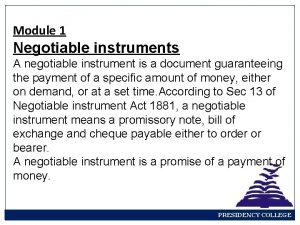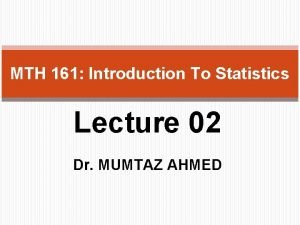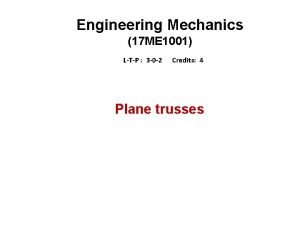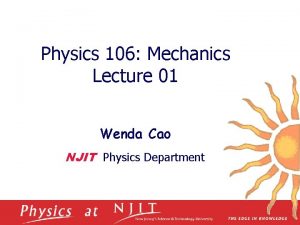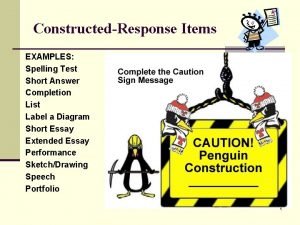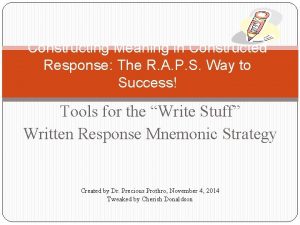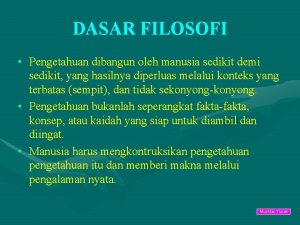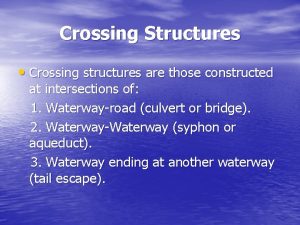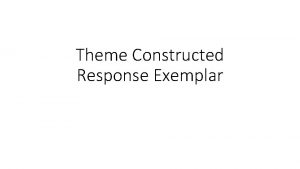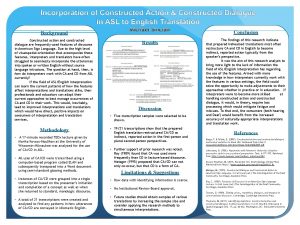Crossing Structures Crossing structures are those constructed at














- Slides: 14

Crossing Structures • Crossing structures are those constructed at intersections of: 1. Waterway-road (culvert or bridge). 2. Waterway-Waterway (syphon or aqueduct). 3. Waterway ending at another waterway (tail escape).

Road Water way Culvert or Bridge Water way Syphon or Aqueduct Water way Tail escape

Culvert

The culvert is a closed conduit (pipe or box section) constructed to carry the discharge of a waterway under a road. The selection of the type of the culvert is based on the discharge as follows: • For Q ≤ 3. 0 m 3/sec use Pipe culvert. • For Q ≤ 12. 0 m 3/sec use Box section.

≥. 15 m ≥. 3 m d D S H

Hydraulic Design The purpose of the hydraulic design is to select the culvert’s dimensions. The dimensions are selected based on: • Velocity through culvert between 1. 0 to 2. 0 m/sec. • Head losses is less then 15 cm. • Entrance submergence is at least 30 cm.

The only equation available is the continuity equation: Q=A. V Where Q is the discharge in m 3/sec, A is the culvert’s cross section area in m 2, and V is the water velocity through the culvert in m/sec. Since the discharge is known, the velocity must be assumed to determine the dimensions of the culvert. The velocity is usually assumed between 1. 0 and 2. 0 m/sec for practical reasons.

Once the dimensions are determined, then head losses must be checked. Head losses are calculated as follows, Where Hl is the head losses in m V is the velocity in m/sec g is the acceleration of gravity

Ce is the entrance coefficient of loss (= 0. 5 ) Cf is the friction coefficient Co is the outlet coefficient of losses ( = 1. 0 ) Friction coefficient can be calculated as follows,

Where f is coefficient depends on the culvert material and dimension, L is the length of the culvert and m is the hydraulic radius. The coefficient a and b are constant and depends on the material of the conduit. For Steel: a = 0. 0048, b = 0. 0256 For Concrete: a = 0. 00316, b= 0. 0305

• Example 1: Design a culvert under a road. The discharge is 3 m 3/sec and the water depth is 1. 8 m. The culvert length is 20 m. • Sol. Q = 3 m 3/sec * use pipe culvert assume V=1. 3 m/sec A = Q/V = 2. 31 m 2 A = ∏ D 2/4 * D = 1. 7 m However, D ≤ 1. 8 – 0. 3 … 1. 5 m

Then use 2 pipes …one pipe A = 1. 155 m 2 D = 1. 3 m …. V = 1. 13 m/sec … OK Check of heading up m = D/4 = 0. 325 m f = 0. 0052 Cf = 0. 32 Hu = (1. 13)2/(2*9. 81) *(0. 5+0. 32+1) = 0. 12 m … OK

• Example 2: design a culvert under a road. The discharge is 5 m 3/sec and the water depth is 2. 2 m. The culvert length is 20 m. • Sol. Q = 5 m 3/sec … Use Box culvert Assume V = 1. 3 m/sec A = Q/V = 3. 85 m 2 H = 2. 2 – 0. 3 = 1. 9 m S = 3. 85/1. 9 = 2. 0 m

S < 1. 5 H … OK V = 5/(1. 9*2) = 1. 32 m/sec Check for Heading Up m = 2*1. 9/(2+1. 9)*2= 0. 49 m f = 0. 00336 Cf = 0. 14 Hu = 0. 145 m … OK
 Mikael ferm
Mikael ferm Sans recourse endorsement
Sans recourse endorsement Advantages of complete floor stock system
Advantages of complete floor stock system A solid barrier constructed at a suitable location
A solid barrier constructed at a suitable location Why are frequency distribution constructed
Why are frequency distribution constructed Short-answer constructed response questions (crq)
Short-answer constructed response questions (crq) Plane truss and space truss
Plane truss and space truss Why are frequency distribution constructed
Why are frequency distribution constructed A race track is constructed such that two arcs of radius 80
A race track is constructed such that two arcs of radius 80 Completion item
Completion item Constructed response meaning
Constructed response meaning Ladybug dichotomous key
Ladybug dichotomous key Constructed response questions examples
Constructed response questions examples Eas constructed response examples
Eas constructed response examples Constructed knowledge
Constructed knowledge

